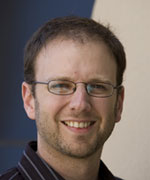From the editor: Starting up the Large Hadron Collider
 |
| Photo: Reidar Hahn, Fermilab |
On September 10, physicists and physics enthusiasts around the world watched expectantly as CERN attempted to circulate particle beams in the Large Hadron Collider for the first time. Those of us watching from the United States stayed up late and tried to get one of the precious Web connections to the streaming broadcast of the event.
In less than one hour—thereby winning LHC Project Leader Lyn Evans a bet—the first beam had made it, sector by sector, all the way around the 27-km tunnel and back to the starting point. Never had two dots appearing on a computer screen so excited so many people. (See the logbook in this issue of symmetry.) Later that morning, a beam was circulated in the opposite direction and the first beam injection for the LHC was complete, more smoothly and rapidly than most people expected. The successful first beams are a testament to the immense effort of a worldwide collaboration of scientists, engineers, and support staff. The whole team deserves the flood of congratulations they received.
As symmetry readers are probably aware, the LHC suffered an interruption to the smooth startup when a faulty electrical connection failed, causing a magnet to quench and helium coolant to leak. Although this is a setback, to be sure, there is nothing too surprising about an incident like this. Essentially all particle accelerators have suffered similar problems in the startup process. The LHC is a machine of unprecedented complexity, and no scientist ever expected to just throw a switch and have the machine operate. LHC engineers and scientists will repair this fault, start the machine up again, probably deal with a number of other minor problems, and then, some time next year, see first collisions. At that time, the science begins and theorists predictions will be under the microscope (see the Essay: Robin Hanson).
Meanwhile, there is a world of particle physics going on outside the LHC. Over the summer, the BaBar collaboration at SLAC released some outstanding results. Physicists had been looking for the lowest-energy state of bottomonium, a particle with bottom and anti-bottom quarks, for 30 years and finally nabbed it (see BaBar and the Very Tiny Particle ). The eta sub b might not have the name recognition of the Higgs boson, but the story of finding it well illustrates just what it takes to make a discovery in particle physics.
The answers to our scientific questions wont come only from energy-frontier machines. Astrophysicists are good-naturedly racing to beat particle physicists to the discovery of dark matter and an understanding of the dark universe (see The Dark Universe Debate). For those physicists trying to be the first to discoveries, the pressure is on while the LHC gets back on its feet. But they had better hurry: The LHC will be up and running in no time.
David Harris, Editor-in-chief
Click here to download the pdf version of this article.


